It’s happened to all of us at least once. You watch Magnum Force and Sudden Impact back to back and you think to yourself “To heck with all this semi-auto nonsense. I need to carry a big. Flippin’. 44. Magnum. Revolver.”
But is that a good idea? Let’s go over the pros and cons of using the 44 Magnum for self-defense so you can decide if becoming Dirty Harry is a sound plan or simply a Hollywood fantasy!
44 Magnum for Self-Defense: Powerful!

That’s 44 magnum in the middle. Plenty of power that’s obvious from the size alone relative to other cartridges.
There are no two ways about it: The 44 Mag is a powerful pistol cartridge. When Inspector Harry Callahan called his revolver “the most powerful handgun in the world,” he wasn’t joking. Although the more powerful 454 Casull was already in development when Dirty Harry premiered in 1971, no revolver had yet been created to fire it!
A 44 Mag cartridge loaded with a 240 grain bullet (which weighs approximately 0.55 ounces) can easily exit a revolver’s barrel at a velocity of 1,180 feet per second (fps). (For reference, the speed of sound is 1,125 fps.) Such a cartridge would deal over 700 foot-pounds (ft lbs) of energy at close-range, or 741 ft lbs of energy at the exact moment it exits the barrel (aka muzzle energy).
What is a foot-pound? It’s a unit of energy required to raise one pound a distance of one foot. Conceptualizing that can be difficult, so here’s a quick side-by-side of other pistol cartridges’ muzzle energies for reference.
44 Mag’s Energy Relative to Other Handgun Calibers
| Cartridge | Muzzle Energy (ft lbs) |
|---|---|
| 22 LR | 131 |
| 32 ACP | 161 |
| 380 ACP | 210 |
| 38 Special | 225 |
| 22 WMR | 324 |
| 44 Special | 336 |
| 45 ACP | 356 |
| 9mm | 364 |
| 40 S&W | 500 |
| 357 Magnum | 539 |
| 357 SIG | 583 |
| 41 Magnum | 614 |
| 10mm | 708 |
| 44 Magnum | 741 |
| 454 Casull | 1,813 |
| 460 Magnum | 2,309 |
| 500 Magnum | 2,877 |
Note: This chart is intended for convenient reference only. A single type of cartridge’s muzzle energy can vary widely based on factors including bullet weight, muzzle velocity and barrel length.
But the 44 Mag can do a lot more damage than 741 ft lbs. A 44 Mag +P+ cartridge, which is loaded to generate a higher chamber pressure that produces a much faster muzzle velocity, can easily deliver a muzzle energy in excess of 1,500 ft lbs!
While the 44 Mag is by no means the most powerful pistol cartridge, it’s more than powerful enough to IMMEDIATELY neutralize even the most determined, drug-addled threat to your personal safety. Common knowledge holds that you want a cartridge for self-defense that will hit a threat with 220 to 300 ft lbs of energy. The 44 Mag easily transfers twice the maximum energy recommended for self-defense, and that’s not taking into account a hollow point bullet’s ability to expand outward during penetration. Heck, even if it doesn’t expand at all, a 0.429” diameter bullet is going to leave a nasty mark.
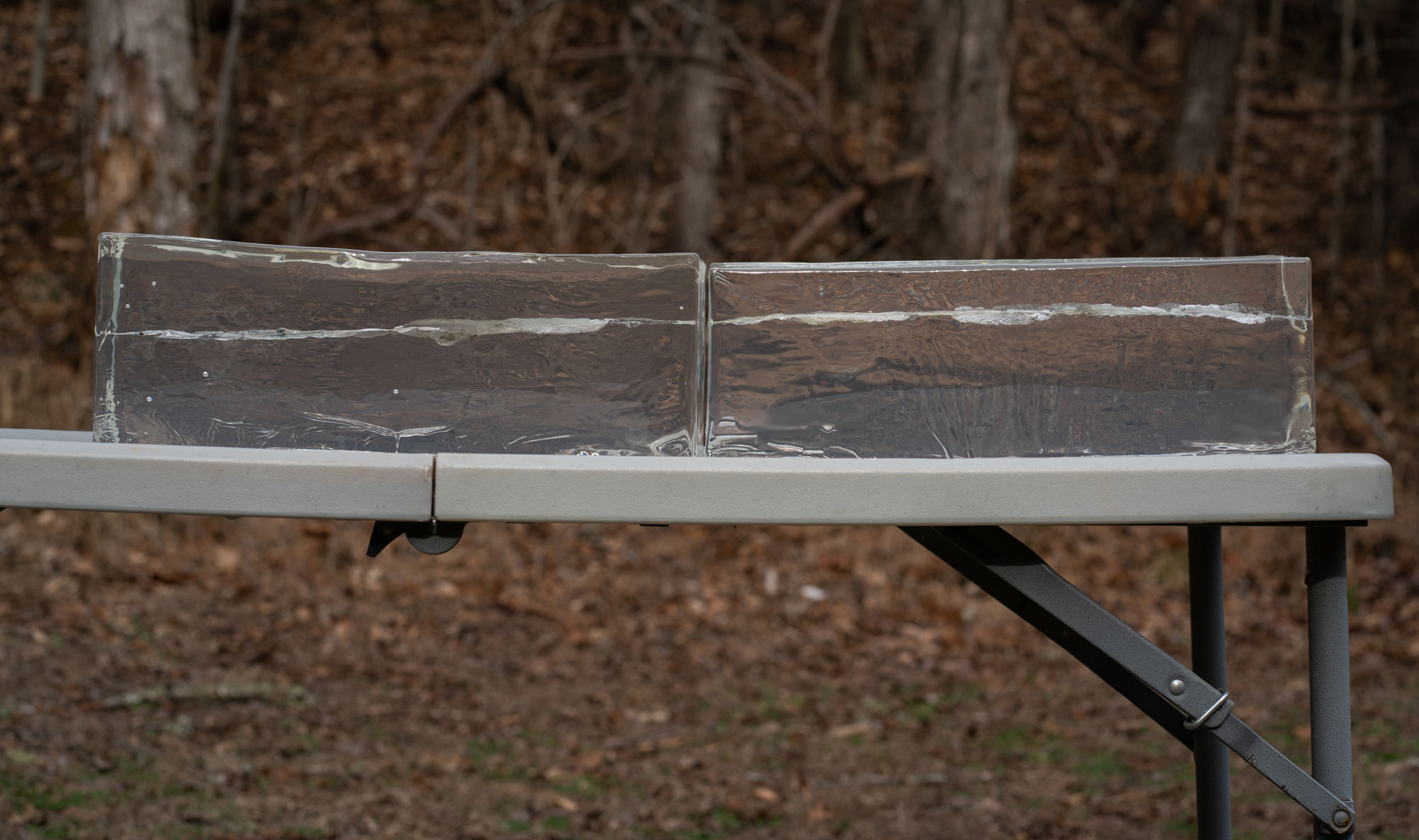
We tested Hornady’s FTX which packed enough power to clear through two gel blocks. Federal’s Fusion displayed similar strength, stopping just short of clearance through the second block.
Con: Too Powerful?
You could argue that there’s no such thing as overkill when it comes to your personal safety. When someone means to kill you, you don’t mean to do them any favors in return.
But it’s important to remember that you’re responsible for every shot you fire, even when your life is on the line. One of the reasons police use expanding hollow point bullets is because they reduce the chance of overpenetration, which could jeopardize innocent bystanders. A 44 Mag round is so powerful, however, that there is a very good chance its bullet will pass completely through a human-sized target and keep going – even if that bullet is designed to expand inside soft tissue.
The 44 Mag’s excessive power leads to its other great shortcoming: recoil.
Con: 44 Magnum Brings Big Recoil
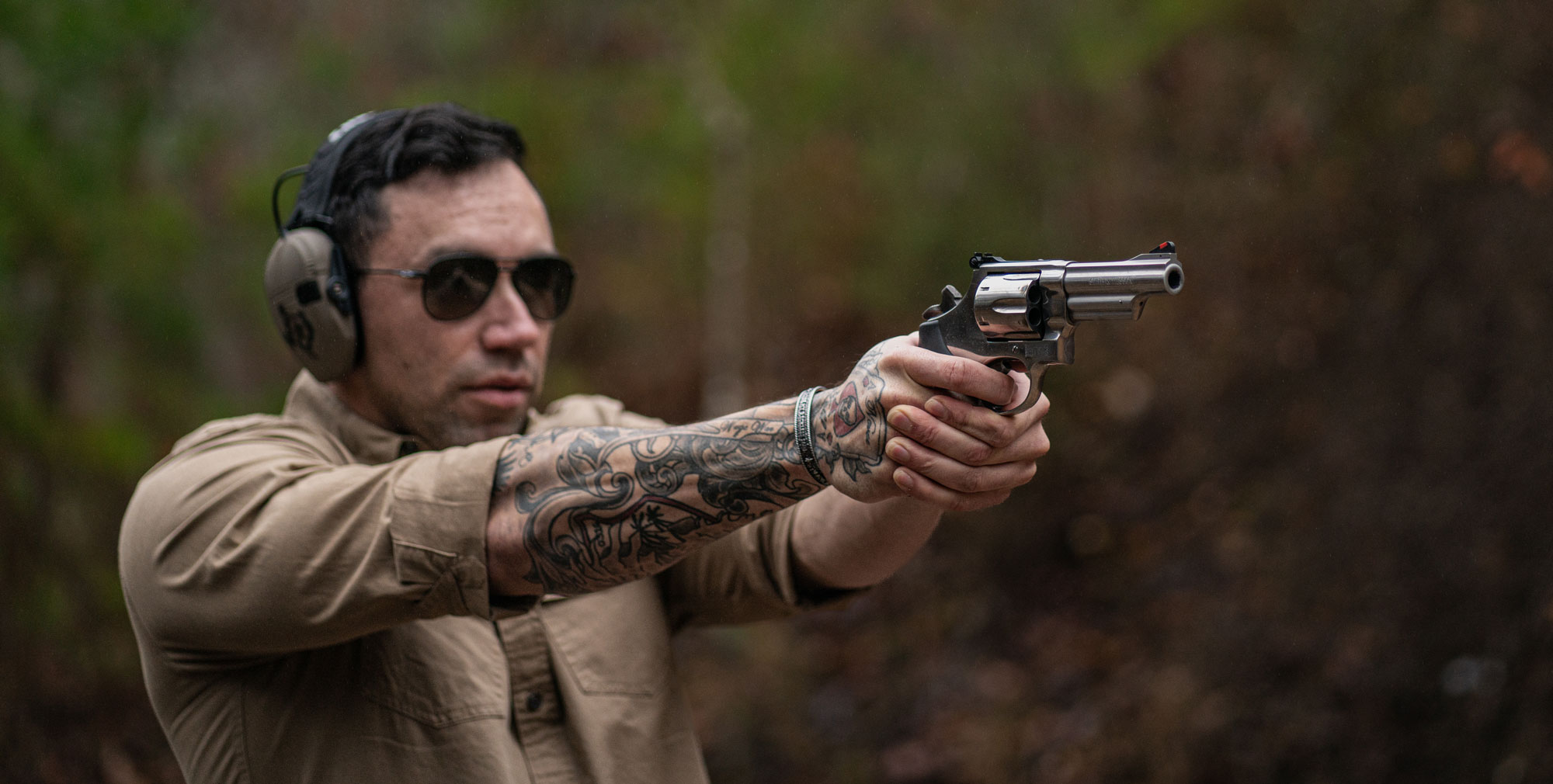
Recoil (commonly called “kick”) is when a firearm jerks backward during ignition. Heavy recoil isn’t desirable, and not just because it makes firing less comfortable. Stronger recoil also jerks a firearm’s barrel farther upward, which in turn increases the amount of time required to aim and fire the next shot.
In other words, the stronger the cartridge, the harder it becomes to fire quickly and accurately.
Now, we can’t promise how much recoil you’ll actually perceive when you fire a handgun. That’s purely subjective, so we can’t measure it. That said, here are some common handgun rounds’ recoil energies so you can get a rough idea of how much kick each produces.
| Cartridge | Recoil Energy (ft lbs) |
|---|---|
| 22 LR | 0.5 |
| 32 ACP | 0.7 |
| 380 ACP | 3.1 |
| 44 Special | 3.9 |
| 45 ACP | 4.4 |
| 9mm | 4.6 |
| 38 Special | 6.1 |
| 40 S&W | 6.5 |
| 45 GAP | 6.6 |
| 357 SIG | 6.7 |
| 357 Magnum | 7.9 |
| 10mm | 8.7 |
| 44 Magnum | 13.7 |
| 454 Casull | 21.3 |
| 500 Magnum | 45.1 |
Note: Cartridge recoil energy varies widely according to factors including muzzle velocity, bullet weight and firearm weight.
The 44 Mag is a kicker for sure. You won’t find any real world police officers using it for this very reason – firing the thing rapidly and with any accuracy at all can be really tricky!
Con: Most 44 Mags Are Heavy Handgun
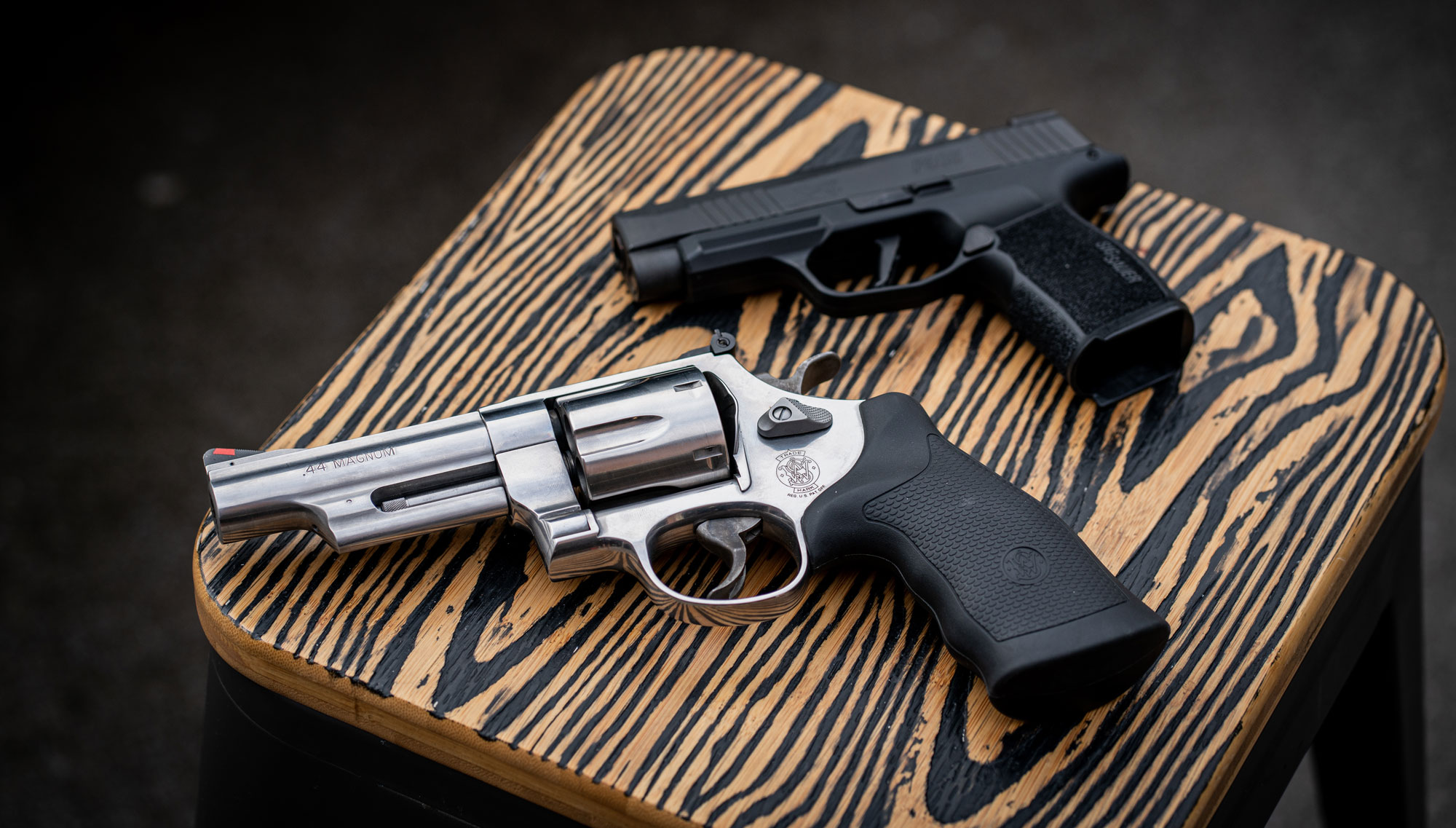
As a general rule, the more powerful the cartridge, the heavier the handgun. This is largely because a handgun has to have a certain amount of substance to it in order to absorb a cartridge’s recoil and chamber pressure. Too lightweight a 44 Mag pistol would kick like crazy and/or explode!
If you decide to carry a 44 Mag for personal protection, you’re going to wind up hauling around a lot of gun. You’re going to become increasingly aware of that big chunk of metal as the day wears on, and realize why people prefer smaller handguns for concealed carry even though they may not be relatively powerful.
Here’s a chart comparing the weights of several different handguns to give you a better idea of what we’re talking about.
| Handgun | Cartridge | Weight (lbs) |
|---|---|---|
| Glock 42 | 380 ACP | 0.8 |
| S&W 442 | 38 Special | 0.9 |
| S&W 360 | 357 Magnum | 0.9 |
| Charter Arms Mag Pug | 32 ACP | 1.3 |
| Glock 17 | 9mm | 1.4 |
| Glock 23 | 40 S&W | 1.5 |
| SIG Sauer P239 | 357 SIG | 1.6 |
| Ruger Mark IV | 22 LR | 1.8 |
| Glock 20 | 10mm | 1.9 |
| S&W Triple Lock | 44 Special | 2.4 |
| M1911A2 | 45 ACP | 2.4 |
| S&W 629 | 44 Magnum | 2.8 |
| S&W 500 | 500 S&W | 4.3 |
| S&W 460XVR | 454 Casull | 4.5 |
Note: These weights are for empty handguns. They become significantly heavier with loaded magazines or cylinders.
The Takeaway on Using 44 Magnum for Self Defense
No human threat will survive a direct hit to the head or center of mass with a 44 Mag revolver. No way, no how, unless they’re wearing some pretty fancy body armor.
But that comes with significant setbacks. The 44 Mag is fairly likely to pass through a threat altogether and potentially jeopardize an innocent bystander. It kicks like a surly racehorse. If you miss, the threat will have a wide opening to retaliate. Finally, revolvers chambered for 44 Mag are fairly bulky and inconvenient to carry around all day.
So: Is the 44 Magnum good for self-defense? Yes, absolutely. You just have to appreciate all the downsides before you sign up to become the next Dirty Harry. And, when you do, we have all the 44 magnum ammo you need for sale here.

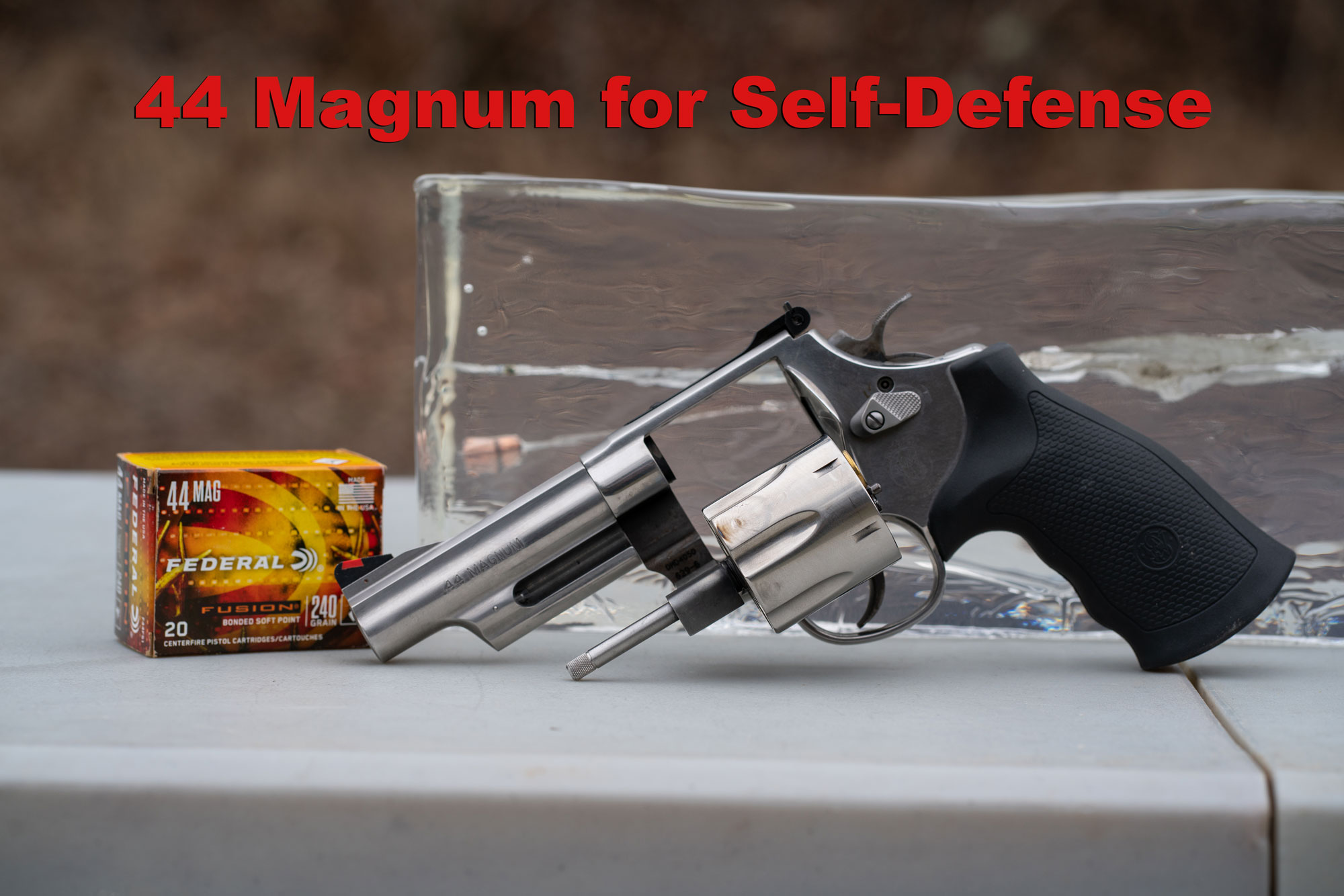
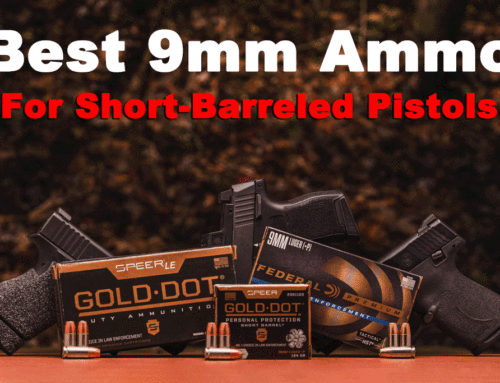
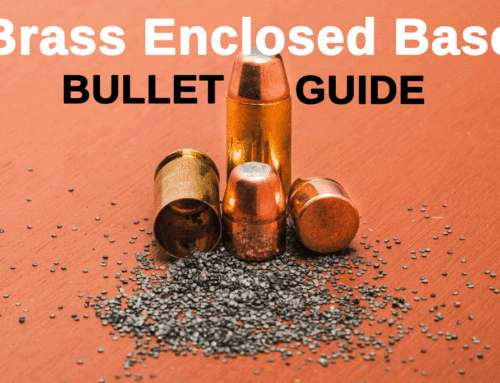
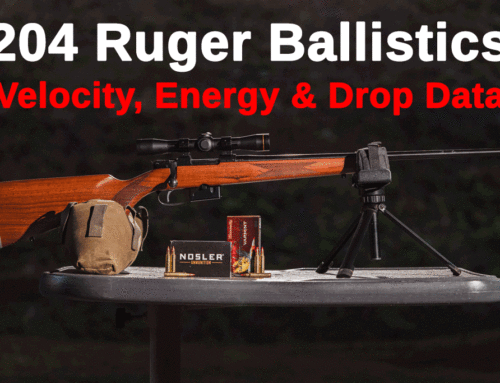
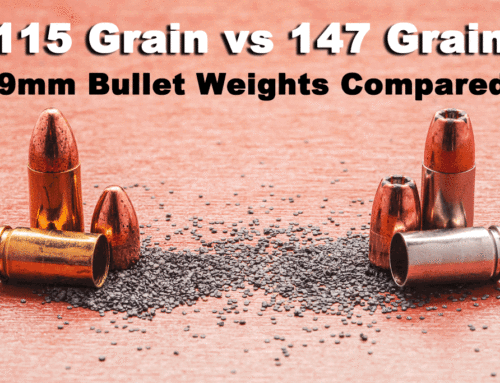
Very good article and I agree if you only live in urban areas but if not there’s a another pro if two legged beast is the Threat you can load 44 special for carry very accurate round if in the back country load 44mag good hunting and self defense if dealing with bears hogs or packs of wolfs you will not mind the weight very good caliber for the man with the man that only needs one gun hi
Very good info. I just purchased a S&W 44 mag revolver for both self defense and I camp on BLM land((boondock camping)). Never know what you will run into in AZ((both human and animal coyotes)) and ID.
You may want to specify Bureau of Land Management. These days BLM doesn’t elicit a federal land management response.
haha – fair point! :)
One word cavitation! Any human hit with a 44 mag is out of the fight. And if it’s me call it training or kama I want double taps.
Great article. I purchased a Ruger 44 magnum, glad I did. I’m an avid fishermen and go on my bosses farm which has a large pond on it. The other day I was charged by a pretty good size black bear. One shot took it down. I still wouldn’t recommend it for personal defense because of the recoil (to long to re-aim) unless you are an expert marksman.
Dang, that’s a heckuva story! Glad you’re alright and the 44 Mag was enough to take care of that bear.
I carry several different guns over the course of the year. For a long time, my EDC varied based on the weather and what I was wearing as cover. These days I pretty well carry whatever I feel like and the weather has less effect on my choice. But on a regular bases I carry a S&W Model 19 Performance Center .357, a S&W Model 629 Performance Center .44mag, a S&W M&P 5.7 and a Glock 19. I also keep a pocket sized 9mm as a backup. Over time you learn how to buy and dress in a way that offers support to your waistline for carrying a heavy firearm. And truth be told, the 44 carries with less printing that the .357, even with its increased mass.
I don’t carry the 44 quite as much as I used to, because exactly as described in the article it is difficult to put a second shot on target with the recoil. Honestly it is not a pleasure to shoot in the least. Quite frankly, it dam near hurts due to the design of the wood grips and how they fit the frame. Of late I’ve carried the 5.7 more than the rest, however it is the largest in size of the bunch. But it also carries 22 in the mag and 1 in the pipe. So it makes up for what it lacks in punch with volume.
I am making a purchase from a friend’s father next week of a rugar 44 super Blackhawk his wife has passed and he is moving with his son in Florida and won’t be hunting anymore he ask me if i wanted it and I told him I would give him 500 it’s a beautiful piece I have his 257 rifle he had jus love that gun